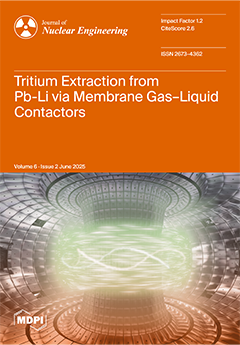(1) Background: Generation IV supercritical water-cooled reactors (SCWRs), including small modular reactor (SCW-SMR) variants, are pivotal in nuclear technology. Operating at 300–500 °C and 25 MPa, these reactors require detailed understanding of radiation chemistry and transient species to optimize water chemistry, reduce corrosion,
[...] Read more.
(1) Background: Generation IV supercritical water-cooled reactors (SCWRs), including small modular reactor (SCW-SMR) variants, are pivotal in nuclear technology. Operating at 300–500 °C and 25 MPa, these reactors require detailed understanding of radiation chemistry and transient species to optimize water chemistry, reduce corrosion, and enhance safety. Boron, widely used as a neutron absorber, plays a significant role in reactor performance and safety. This study focuses on the yields of radiolytic species in subcritical and supercritical water exposed to
4He and
7Li recoil ions from the
10B(
n,α)
7Li fission reaction in SCWR/SCW-SMR environments. (2) Methods: We use Monte Carlo track chemistry simulations to calculate yields (
G values) of primary radicals (e
−aq, H
•, and
•OH) and molecular species (H
2 and H
2O
2) from water radiolysis by α-particles and Li
3⁺ recoils across 1 picosecond to 0.1 millisecond timescales. (3) Results: Simulations show substantially lower radical yields, notably e
−aq and
•OH, alongside higher molecular product yields compared to low linear energy transfer (LET) radiation, underscoring the high-LET nature of
10B(
n,α)
7Li recoil nuclei. Key changes include elevated
G(
•OH) and
G(H
2), and a decrease in
G(H
•), primarily driven during the homogeneous chemical stage of radiolysis by the reaction H
• + H
2O →
•OH + H
2. This reaction significantly contributes to H
2 production, potentially reducing the need for added hydrogen in coolant water to mitigate oxidizing species. In supercritical conditions, low
G(H₂O₂) suggests that H
2O
2 is unlikely to be a major contributor to material oxidation. (4) Conclusions: The
10B(
n,α)
7Li reaction’s yield estimates could significantly impact coolant chemistry strategies in SCWRs and SCW-SMRs. Understanding radiolytic behavior in these conditions aids in refining reactor models and coolant chemistry to minimize corrosion and radiolytic damage. Future experiments are needed to validate these predictions.
Full article





